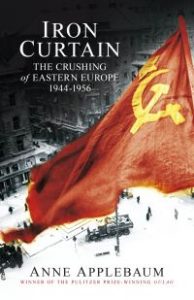 Review by Csaba T. Chikes, Editor of American Diplomacy
Review by Csaba T. Chikes, Editor of American Diplomacy
Iron Curtain: The Crushing of Eastern Europe 1944-1956 by Anne Applebaum, Anchor Reprint, 2013, ISBN-13: 978-1400095933, 640 pp. $23.79 (Hardback), $13.80 (Paperback), $11.85 (Kindle edition)
Well before Secretary Rumsfeld famously taunted reluctant Western European NATO allies as “Old Europe” while praising the recently allied East European countries as “New Europe,” these former Warsaw pact members were also characterized in the literary world as the “Other Europe.”
As General Editor of a 1974-1989 Penguin Books paperback series entitled: Writers from the Other Europe, Philip Roth oversaw publication of Eastern European writers relatively unknown to American readers. By 1990, the series title would no longer apply because the “other” Europe had shaken off the near half-century nightmare of Soviet domination.
Fans of Ms. Applebaum’s columns and her Pulitzer Prize winning book, Gulag will be delighted with her latest book, Iron Curtain: The Crushing of Eastern Europe 1944-1956, a definitive case study of precisely how these countries became “the other Europe.”
Recent attention by historians has focused on the hideous fate of the large strip of Europe trapped between Hitler and the Stalin throughout the bulk of the fighting during WWll (Bloodlands) and, even after the surrender of Nazi Germany in 1945 (The Savage Continent). For while the war‘s end was being joyously celebrated throughout the U.S. and Western Europe, entire populations within Eastern Europe suffered merciless vengeance with a special Stalinist hell aborning in each.
The Red Army practice of mass rape of the women of vanquished enemies as a spoil of war was but the prelude to what was to follow.
Iron Curtain provides a granular examination of the process by which the Kremlin methodically — and patiently — imposed the stranglehold subjugation of three eastern European countries, Poland, East Germany and Hungary. The author relates the detailed descent into totalitarian darkness from which escape came only after a near half -century of totalitarian deprivation.
Most Americans are probably familiar with the basics of the political-military situation at the conclusion of WWII, which found the Red Army in unchallenged occupation of six countries along its western frontier. Stalin correctly surmised that the British and American electorate had no stomach for any continued military action in support of the independence of these occupied countries. Churchill understood perfectly well what the endgame would look like but was sidelined by UK voters two months after VE Day.
Drawing on recently available security archives and interviews to better fill out the documented history of the impact on everyday lives of Stalinization, Ms. Applebaum has produced a work which subjects the reader to a horrified fascination akin to the experience of a Nature Channel documentary’s scene of a constrictor relentlessly reducing its prey to inevitable doom.
The book makes clear that the fate of these occupied Eastern European countries was sealed by Stalin’s preparations, carried on without interruption even with the Soviet Union desperately engaged in life and death struggle with Germany’s launch of Operation Barbarossa in 1941.
Sheltered safely hundreds of miles east of Stalingrad and Leningrad’s fields of slaughter, Communist activists from each of the future Warsaw Pact countries were prepared for execution of elaborately detailed plans to seize control of their native lands after the Red Army occupied them.
It is important to note that in this effort, the Soviets would not trust local East European Communists who had engaged the Nazis throughout the occupation because their credibility was compromised by the very fact of their survival.
Apropos, readers will be reminded of George Orwell’s heartbreaking epiphany in Homage to Catalonia that in providing material support to the various leftist groups (“fronts”) united in the war against Nazi-supported Spanish fascism, Moscow’s overarching objective was the ultimate supremacy of its proven acolytes among the groups.
Ms. Applebaum summarizes the outlines of the Soviet effort as follows, in priority order:
-
- Immediately install a secret police organization patterned upon and directed from Moscow by the KGB precursor, NKVD;
- establish complete control of all radio broadcasting content and transmission apparatus;
- subvert and ultimately dominate all manifestations of civil society by absorbing all into “united fronts” answering to the Communist Party (Boy Scouts, YMCA, churches and religious organizations, etc.)
- institute ethnic cleansing on a mass scale through deportations of entire populations
She also explains, that while Moscow planners remained convinced of the ineluctable victory promised by their ideology, they were also quite practical in their application of lessons learned during their own history, but particularly the recent experience of imposing Stalinization on the countries that fell under their control during two years that the Molotov–Ribbentrop Pact was in effect.
The pace of Stalinization of Eastern Europe has always been perplexing. One cannot but wonder why, given their unchallenged overwhelming hegemony, did the Soviets approach the completion of their takeover at such a measured pace. Certainly the endgame had been long determined and the necessary elements well in place from the outset. Why, then, in the case of Hungary, for example, did it take some five years for the Communist Party to seize everything they desired?
Ms Applebaum’s answer is that Stalin and his East European comrades took their own ideology quite seriously. They regarded the transition to complete Stalinization to be one requiring passage through necessary historic “stages” in some form, emphasizing the creation and subversion of “united fronts” in all areas of civic society in place of simplistic coups d’état.
“Iron Curtain” calls into question some of the premises of revisionist Cold War historiography of the past few decades that emphasize the perspective of the Soviet response to Western aggression in analyzing post WWII and Cold War Soviet behavior. Her research makes a compelling case that the Soviet disposition of Eastern Europe was driven less by defense against Western designs on their sovereignty than by a militant ideology which promised the successful establishment of their new world order on the ruins of war.
Ms. Applebaum also helps clear up the confusion, befogging U.S. political discourse in a conflation of “socialism” and “communism”. The more remarkable given that fact that our NATO allies — and Israel, for that matter — have all been governed by Socialist (Social Democratic) parties at some point and yet are not communist tyrannies.
As Applebaum points out, the WWII communist overlords of the Red Army shared no such confusion. Commenting on the attitude of Red Army General Ivan Serov (charged in 1944 with cleansing Poland of political undesirables) toward Polish activists from the extreme right, she notes that: “Serov was not interested in Piasecki’s Falangist past: like most Soviet officials, he considered anyone who was not a communist to be ‘far right’ by definition, and distinctions between social democrats and radical right-wingers did not concern him.” (p. 404)
Indeed, Stalin, Hitler and Mussolini had recently persecuted Socialists with special ferocity alike throughout the 1920’s and 30’s, making them early victims of Nazi concentration camps.
Those trapped behind the Iron Curtain after 1947 would not likely have believed claims of the communist totalitarian government ruling them that it was actually a Socialist party. Certainly by 1965 Hungarian Socialists had long been executed or imprisoned by the communists.
Iron Curtain populations were also well aware — despite the ceaseless barrage of Communist propaganda – that their Western European neighbors on the other side of the curtain were often ruled by Socialist parties who took and left power according to the wishes of their electorate. This awareness was especially heightened once travel to the West became less restricted in some of the Warsaw Pact countries during the twilight years of communist rule.1
Iron Curtain whets the appetite for an equally well-researched sequel to this history that would lay out the varied path to liberty taken by these three countries post 1989. The overall context of Soviet domination, of course, would remain a constant throughout, from the descent into enslavement to the emergence into independence. Gorbachev can be seen as a harbinger of their ultimate freedom just as Stalin was the embodiment of their enslavement.
Specifically, how did it come to pass that these countries, whose domination followed a strict Stalinist playbook identically in each, ultimately arrived at freedom following such differing paths out of the same Soviet empire.
For example, Hungary evolved from the experience of the bloodiest of the anti-Soviet revolutions in the bloc, to a position of the Cold War’s “happiest barrack” in the Warsaw Pact. With a Communist leader who frequently stated, “he who is not with us is against us” in his rally speeches, steering a party steadily toward as much liberalization in the areas of consumer goods, property ownership and overseas travel as feasible within the restraints of the Soviet sphere, Hungary did not experience the ultimate face-off between huge crowds of demonstrators and security forces so typical of their fellow bloc members final breakthrough to freedom.
Indeed, it was the Hungarian communist party that exposed the hollow reality of the Warsaw Pact by taking down the barbed wire on its Austrian border and allowing East Germans passage to West Germany two months later.
We know now that the Hungarian Prime Minister had told Gorbachev of the planned opening of the border four months before the ceremonial wire cutting of June 1989. Which only underscores the fundamental point that none of the remarkable events of 1989 throughout the Warsaw Pact could have possibly played out the way they did absent a Gorbachev and a Reagan foreign policy open to the opportunities presented.
One factor worth exploring is the degree of influence on this process of U.S. and allied efforts via diplomatic, military-security, informational, and economic measures.
Certainly U.S. policy of “differentiation”, dating as far back as the Johnson administration, by some accounts, was aimed at acknowledging latent national variations among Warsaw Pact countries. A striking manifestation was the controversial (particularly among Hungarian-American circles) return to Hungary in 1978 of the Crown of St. Stephen, which encouraged the evolving Hungarian variety of communist rule.
In sum, “Iron Curtain”, a must read for all students of Eastern Europe, is a most informative and enjoyable read for everyone.![]()
NOTE
[1] A puzzlement: despite all available clarity on the fundamental differences between Socialists and Communists, a widely distributed 2012 US campaign video featuring a 1956 émigré from Hungary describes the hardships of having “grown up in a socialist country”. Astonishing, if not disconcerting, considering that from the completion of the post WWll Communist takeover until the first post-Communist free elections in 1990, the popular national term of reference to the governing party was always “the stinking Communists”, not “the stinking Socialists”. Thus, anyone fleeing the country in 1956 would have indeed suffered the apogee of Communist Party oppression. But the Hungarian Socialist Party first won a four-year governing term only in 1994 and was returned to power from 2002-2008. Ms. Applebaum’s effort to remedy such conflation is laudable.
American Diplomacy is the Publication of Origin for this work. Permission to republish is freely granted with credit and a link back to American Diplomacy.

